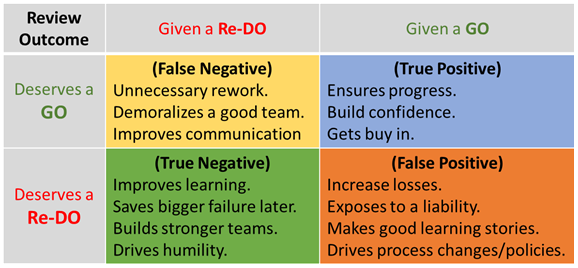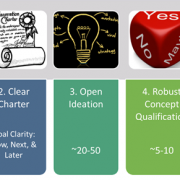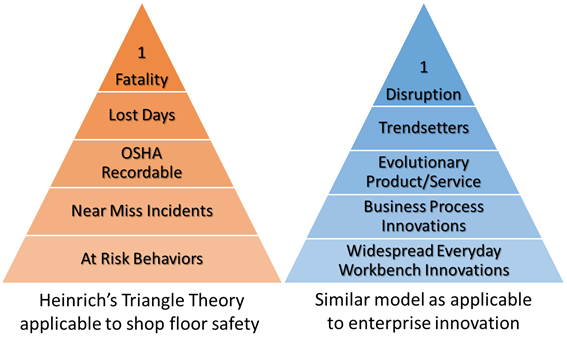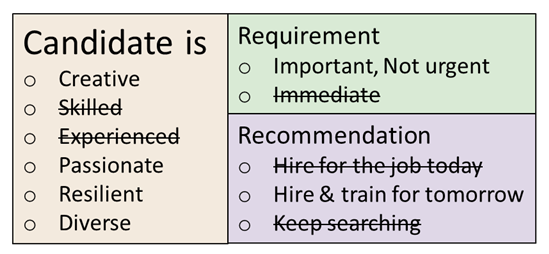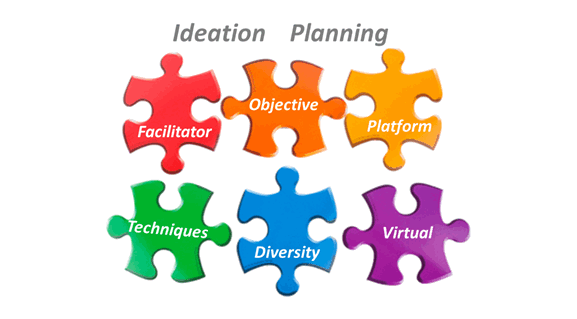Managing Risk in an Innovation Project
Do you know how to conduct a robust gate review?
One of the reasons projects fail miserably is because, we choose to ignore warning signs in early-stage gates and keep pushing it through until it is too late and too big to handle.
Having worked at a major aerospace manufacturer, I had the good fortune of being a part of several reviews at various levels and disciplines – design, technology, component, system, product, manufacturing, process, program, and so on. That process was so mature, that I did not realize what a poor process feels like until I was assigned to develop suppliers. Now having coached over 2 dozen product innovation companies on this topic, I can confidently say that the value of review gates comes from a competent and empowered review team. The review team must be competent to make the right decisions and mentor the team. It must be empowered to judge and stop/redirect a project, despite business pressures.
Significance of Review Gates
A quick story to illustrate the point. After a nasty accident at an intersection, city authorities asked “Why do we not have a STOP sign here?” Reply came back as “People were complaining about seconds lost due to “stop and go” on an intersection with virtually no traffic. Since we have not had an accident here in a long time, we took the sign off, just yesterday.” There is a reason for a 4-way stop sign. Stop and look for what is coming from the side?
For Business Leaders: Annual or quarterly strategic reviews serve this purpose, to pause and look for where the competitor might be coming from. All it takes is a little time with the Board of Directors to properly re-position for success.
For Innovation Managers: A review gate with a pre-defined success criterion is a recognized best practice. All it takes is a little time with a group of experts to mitigate risk and quality concerns and redirect for success.
Gates: Generically speaking, qualified concepts that proceed to become projects may go through these gates:
- Proof of Concept.
- Product/service design and development.
- Performance verification and validation.
- Pilot users and customers.
- Scale-up and capture market share.
Depending upon complexity, confidence, and risk assessment, the project may have more or fewer gates. A simple study project may have an interim content review and final report and review. Complex product design may have a hierarchical gate structure such as component design gate(s) to support a system-level design gate. A very popular example of a gated process is the Technology Readiness Levels used by DoD/NASA and many other commercial organizations. A similar one called Manufacturing Readiness Levels is used by many organizations.
The phase-gate process is to minimize cost and risk of innovation project through synergy and alignment of expectations. The process …
- Defines the review team and lays out the GO/NO-GO criteria upfront.
- Provides a forum and timing to discuss and approve any scope changes.
- Clarifies and adapts the roles & responsibilities during execution.
- Facilitates informed decision making for the continuation of the project based on the availability of resources, business case, and risk analysis.
The outcome of each review gate could be categorized under various classes:
- GO with comments or recommendations for the next phase.
- Conditional GO with specific actions by a date for it to be a GO.
- NO-GO – RE-DO with required actions and return for review.
- NO-GO – HOLD with specific unmet criteria, or changed context, and a temporary hold of the project, for a specific period.
A project should only move forward to the next review gate, when both the product/service development and business development feel that the concept still qualifies; and all the previous gated criteria have been successfully met. Any exception to the review gate or waiver of criteria/ expectations should require a review team approval. The higher the uncertainty, the lower the first pass yield.
With some of my clients, I notice a management metric around increasing the first pass yield of gated reviews. That is not a good practice. It drives many wrong behaviors: (a) a tendency to pick low-risk ideas/projects, (b) to keep working to perfection, and (c) the review team’s bias towards a ‘GO’ outcome. That is all counter to innovation and the purpose of a gated review. We want to fail fast and learn fast. It is OK to track, but do not set a goal for yield.
Review Gate Team
The suggested participation for the project review team under phase-gate process includes these …
- Funding sponsors, who are accountable for profit & loss.
- Product/service line heads, who will eventually own this innovation.
- New Business Development, which must generate revenue from this.
- The project team, to defend the progress and learn from gate experience.
- Chiefs or subject experts, who are responsible for technical excellence.
- Optional invitees, such as retirees, Consultants, or Customers, for wisdom.
The team needs to maintain a healthy level of conflict and collaboration at the same time amongst various roles/disciplines. For example:
- The marketing and development folks should collaborate throughout to work toward the same innovation and timeline.
- Talent development manager and innovation chief should collaborate for proper talent acquisition and development.
- Program manager and Subject Matter Experts could have a conflict all the time for product excellence and project cost/schedule performance.
- Market domain experts and Subject Matter Experts have a conflict or collaborative depending upon customer push and pull for innovation.
Having seen so many reviews with passionate debates, leading to some exciting outcomes, I say “conflict at the review gate is a good thing.” How we choose to resolve that conflict during the review or afterward as an action item, defines the review gate experience and employee engagement with innovation. The team ought to go into the gate review with an open mind, focused on the purpose, objectives, ethics, and educating each other. In the end, both the project and the review teams are all on the same side, fighting uncertainty.
False Calls at the Review Gate
The purpose of a review gate is to reduce the risk, by ensuring continuation if the concept still qualifies. The review team is susceptible to human errors, misjudgment, and decision making with limited information, cost and schedule constraints, or sometimes external pressures.
A true positive (GO when it should have been a GO) ensures progress, confidence, and team buy in.
A true negative (RE-DO when it should have been a RE-DO) improves learning, saves failure later reducing losses, builds stronger teams, and drives humility.
A false negative (RE-DO when it should have been a GO) leads to some unnecessary rework, schedule delays, and a demoralized team when they are confident. The positive that comes out is improved communication.
A false positive (GO when it should have been a RE-DO or a NO-GO) will continue to accumulate losses and even an escape of a poor design to the market leading to liabilities. They usually make good learning stories, which drive process improvements, policies, and even regulations. Both Space Shuttle disasters were calls made under schedule pressure. The case of Boeing 737 Max software shortfall is a review process failure, which is supposed to look at every aspect of “continued operation”.
In Summary,
Create an environment of healthy conflict at the Gate reviews, deliberately. If needed split the review teams into and play it like a mock court with defense and prosecutor to bring out hidden nuggets.
If you like this blog post, you will like my book – “Inspiring Next Innovation Value Chain” available on Amazon.
If you wish to engage with me in a conversation, on this topic, please register for an online session on Feb 25, 2021 at 9AM ET co-hosted by Nerac.

